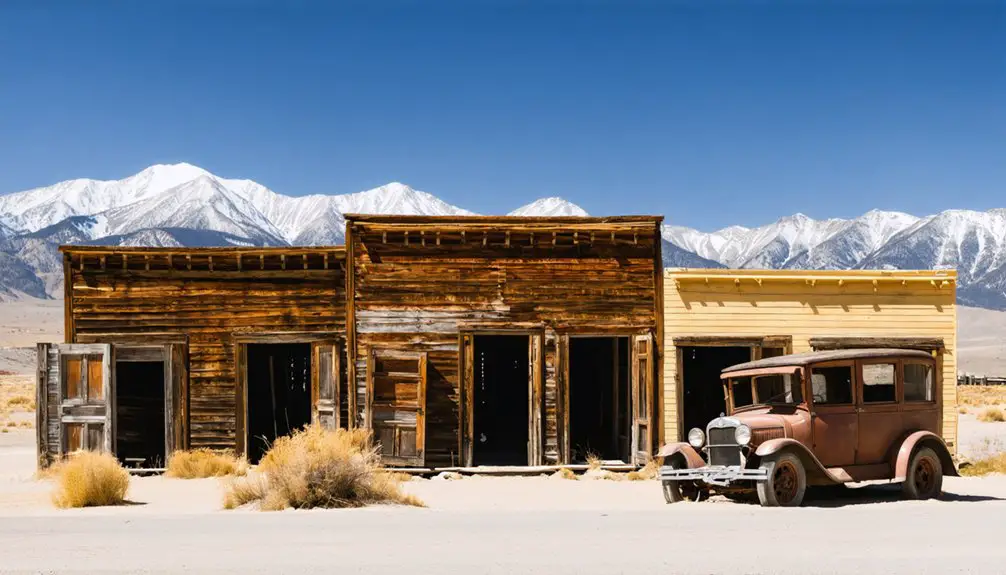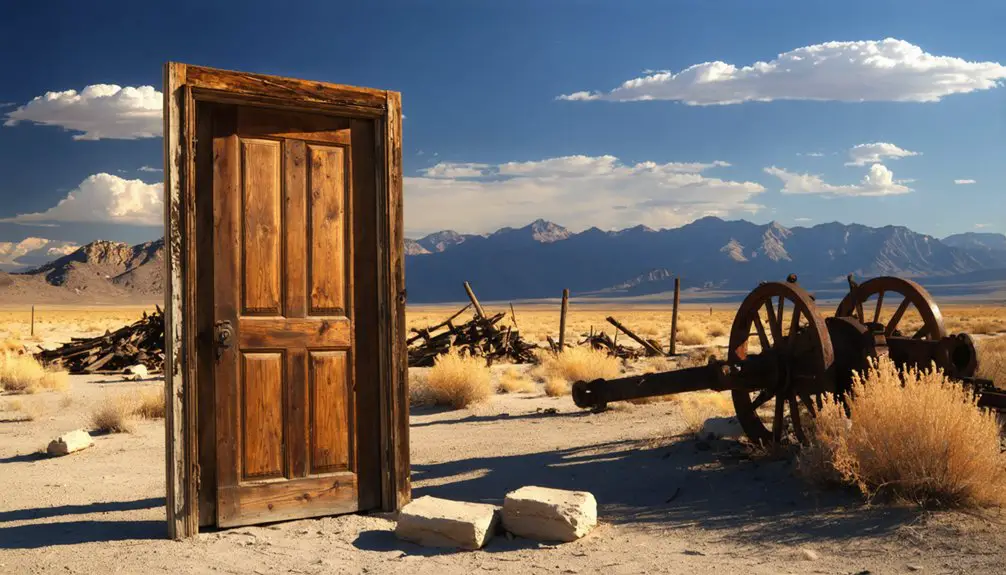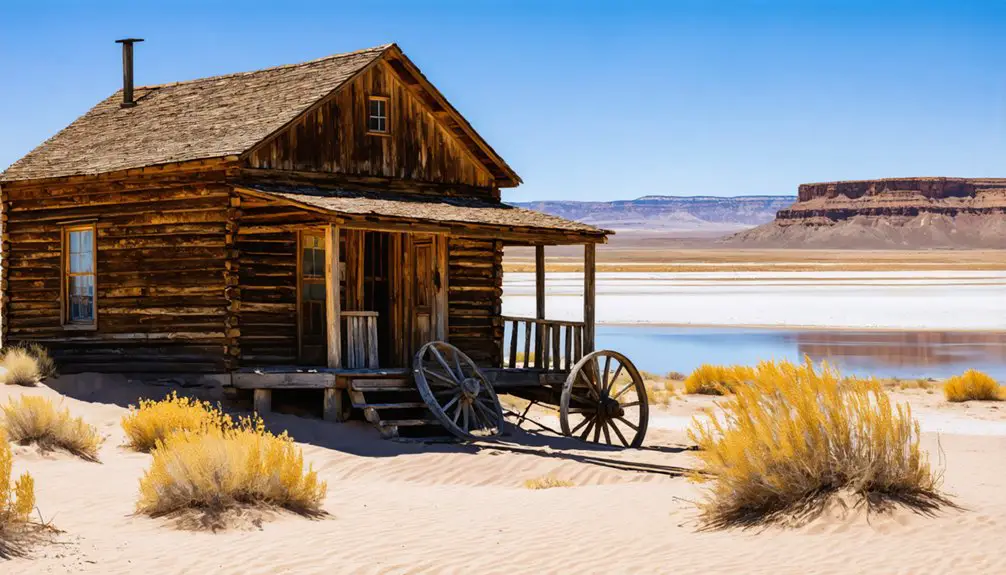You’ll find Desert Lake, a ghost town in Emery County, Utah, established in 1888 by Hans P. Marsing and Charley Winder. Despite initial success with orchards and farming, the settlement faced mounting challenges from water scarcity and salt-contaminated soil. The community of 125 residents enjoyed vibrant social activities until environmental pressures forced their migration to Victor around 1910. Today, scattered foundations, an old house, and a cemetery mark this memorial to pioneer resilience and environmental adaptation.
Key Takeaways
- Desert Lake was established in 1888 by pioneers Hans P. Marsing and Charley Winder, reaching a peak population of 125 by 1906.
- The settlement failed primarily due to water management issues, including salt-contaminated reservoir water and persistent drought conditions.
- By 1920, Desert Lake was largely abandoned after agricultural efforts were defeated by alkali-damaged soil and water scarcity.
- Physical remnants include an old house, windmill, building foundations, and a cemetery with partially marked graves of former residents.
- The ghost town’s location faced severe environmental challenges, including toxic dust releases and ecosystem destruction from receding water levels.
The Pioneer Founders and Early Vision
When three ambitious men, including Hans P. Marsing and Charley Winder, began settling Desert Lake in 1888, they established their founder motivations through strategic water management.
The pioneers’ early documentation helped create a navigation framework for future historical records of the settlement. You’ll find their vision took root in the Cleveland Canal project, where they earned canal stock through their labor – an essential asset for their agricultural innovations. The settlers achieved initial success with orchards and farming operations until a devastating dam failure in 1896.
Establishing the Desert Lake Settlement
Building upon the founders’ initial vision, the Desert Lake settlement took shape in the spring of 1888 as the Thomas and Samuel Wells families joined Hans P. Marsing and Charley Winder in establishing their frontier community.
You’ll find that these pioneering families faced immediate settlement challenges in the arid environment, quickly recognizing that their survival depended on mastering irrigation techniques.
The settlers’ determination led to the construction of an essential canal system and dam to harness water from Huntington Creek.
The community’s reliance on water management faced a significant setback when the dam broke in August 1896.
By 1906, the official townsite survey paved the way for more organized development, with log cabins dotting the landscape.
Despite the harsh conditions, the settlement grew to 125 residents, transforming the desert through innovative water management and a shared commitment to building a thriving agricultural community.
Water Management and Agricultural Dreams
Despite initial optimism surrounding Desert Lake’s 1892 reservoir construction, the settlement’s agricultural aspirations faced mounting water management challenges that would ultimately seal its fate.
You’d have found the reservoir’s limited storage capacity of just a few thousand acre-feet wholly insufficient for large-scale farming dreams. Water scarcity became critical during the 1930s droughts, while salt-impregnated runoff from higher farms contaminated the reservoir’s waters.
The reservoir’s meager capacity and salt-contaminated waters doomed Desert Lake’s farming hopes during the harsh 1930s drought years.
Like early Utah settlers who transformed barren valley areas, Desert Lake’s pioneers discovered the harsh realities of taming arid landscapes for agriculture. Similar to the first pioneers who built irrigation ditches across Utah, Desert Lake settlers worked tirelessly to create water channels for their farms.
Though you could’ve temporarily relied on the Huntington North Ditch for fresher water, this solution proved fleeting. Even attempts at expanding storage through Buckhorn Flat reservoirs fell short, and costly plans to connect with Cleveland Canal never materialized.
The combination of saline runoff and persistent drought forced settlers to abandon their agricultural ambitions, marking Desert Lake’s shift to ghost town status.
Daily Life in a Frontier Community
If you’d lived in Desert Lake during its heyday, you’d have found yourself participating in a vibrant frontier social life filled with house parties, dancing, and regular church gatherings that knit the community together.
Your daily routine would’ve centered around homestead farming activities and tending to orchards or dairy operations, working alongside fellow settlers like the Wells, Powell, and Thayne families to overcome the challenges of alkali soil and water scarcity. Early settlers constructed log cabins for shelter as their first priority upon arriving in the area. Like the residents of Silver Reef, settlers had to endure some of the hottest and driest conditions in Utah.
Beyond the hard work, you could’ve enjoyed C.H. Winder’s local resort offerings of moonlight boat rides and Saturday night dances, or joined neighbors for seasonal recreations like horseback riding in summer and ice skating during the winter months.
Community Social Activities
Life in Desert Lake centered around vibrant social gatherings that fostered a close-knit community spirit.
You’d find yourself drawn to C.H. Winder’s resort for Saturday night community dances and moonlit boat rides on Desert Lake.
The town’s recreational activities ranged from seasonal outdoor pursuits to intimate house parties where neighbors strengthened their bonds.
- Winter brought the thrill of sleigh rides and ice skating, while warmer months saw residents enjoying horseback rides and hay rack adventures.
- Church gatherings served as both spiritual anchors and social hubs for the 125 residents.
- The local store and post office weren’t just service centers – they’re where you’d catch up on community news and connect with fellow settlers.
Homestead Farming Routines
While the sun barely crept over Utah’s horizon, Desert Lake’s homesteaders would already be deep into their morning routines.
You’d start your day with essential homestead chores – milking cows, hauling water buckets across pastures, and tending to livestock before breakfast. Your daily rhythm would revolve around three hearty meals, punctuating the physically demanding schedule. Rest time in the afternoon provided quiet downtime periods for both adults and children.
Livestock management demanded constant attention: rotating pastures, monitoring animal health, and maintaining pens. Similar to Red Acre Farm, families relied on natural farming methods to sustain their operations.
You’d tend your garden near the homestead, fighting weeds and pests while ensuring adequate irrigation. As seasons changed, you’d adjust your routines – spring meant extra vigilance for newborn animals and crop planting, while harvest time required all hands for gathering and preservation.
Each day ended with evening milking and securing animals for the night.
Church and Family Life
Nestled at the heart of Desert Lake’s frontier community, the LDS Church served as both spiritual beacon and social nucleus for settlers. You’d find the church buildings doubling as schools and social halls, with the original Elmo church transformed from a granary into a vibrant gathering space. Much like in Old Iron Town, these spiritual centers were vital to maintaining community bonds during the challenges of frontier life.
Church activities and family gatherings wove together the fabric of daily life, creating an inseparable bond between spiritual devotion and community solidarity.
- Weekend dances, moonlight boat rides, and ice skating brought families together for recreation and celebration.
- Children grew up participating in communal farm work and household duties, learning responsibility through shared labor.
- Women’s essential contributions ranged from organizing church events to teaching in frontier schools, while maintaining households and supporting community projects.
Environmental Challenges and Soil Degradation
As Desert Lake’s waters continue to recede, the exposed lakebed releases severe environmental hazards that threaten both human health and ecological stability.
You’ll find toxic dust containing heavy metals and arsenic becoming airborne, creating significant air quality challenges for nearby communities. These particles can remain suspended for days or even weeks, traveling vast distances and affecting millions of residents in the basin.
The deteriorating conditions have triggered a cascade of environmental problems.
You’re witnessing the collapse of essential species like brine shrimp and flies, which disrupts the entire food web. The exposed soil, stripped of its protective crust, faces rapid erosion and degradation.
When combined with upstream water diversions and climate change-induced drought, these factors accelerate the destruction of this once-thriving ecosystem.
The Great Migration to Victor

The Great Migration to Victor emerged as part of the broader Mormon pioneer movement between 1847 and 1868, when an estimated 60,000 to 70,000 settlers journeyed to Utah Territory.
The migration patterns reflected remarkable ethnic diversity, with British immigrants forming the largest group at 67% of foreign-born residents by 1880. You’ll find that Scandinavian converts, particularly from Denmark and Sweden, established thriving agricultural communities in the valleys near Victor.
British and Scandinavian settlers dominated Victor’s early immigration, with Brits comprising two-thirds of foreign residents by 1880.
- You could travel by wagon train, handcart company, or later by railroad after 1869.
- You’d join fellow immigrants from Britain, Scandinavia, Germany, and Canada.
- You’d discover economic opportunities in mining, farming, and commerce.
Religious gathering and economic prospects drove this westward movement, creating a vibrant multicultural landscape that shaped Victor’s early development.
Physical Remnants and Historical Sites
Physical remnants of Desert Lake stand as silent witnesses to its pioneering past, though time has steadily eroded most structures into ruins.
You’ll find an old house with its door still open, accompanied by a creaking windmill marking one of the original homesteads. The town’s physical decay is evident in scattered building foundations and roofless structures that once housed families and farmers.
The Desert Lake cemetery remains the most historically significant site, featuring unmarked and partially marked graves that tell tales of former residents.
You can trace the town’s agricultural heritage through remnants of pioneer-built dams and irrigation ditches spanning roughly two square miles.
While C.H. Winder’s resort has vanished completely, the modified landscape and building ruins paint a picture of this once-thriving community‘s story.
Legacy of Desert Lake’s Brief Existence

Desert Lake’s brief but impactful existence left an indelible mark on Utah’s pioneer settlement history from 1888 to 1920.
You’ll find a cultural legacy that extends beyond mere agricultural decline, showcasing the resilience of frontier communities in the face of environmental challenges.
- The community’s vibrant social life included Saturday night dances, moonlight boat rides, and various recreational activities that brought 125 residents together despite harsh conditions.
- Agricultural dreams shifted from Desert Lake to Victor around 1910 as alkali-damaged soil forced adaptation, marking a pivotal change in local farming patterns.
- Though the town ultimately succumbed to environmental pressures, its story lives on through oral histories and artifacts, representing a broader pattern of Western settlement and adaptation.
Frequently Asked Questions
What Role Did Native Americans Play in the Desert Lake Area?
You’ll find the area’s Native Heritage centered on Goshute people who hunted waterfowl, gathered plants, and maintained Tribal Relations until Mormon settlers disrupted their traditional desert-lake subsistence practices in the 1800s.
Were There Any Notable Crimes or Law Enforcement Incidents?
With just 125 residents at its peak, you won’t find any documented crime history or law enforcement incidents in Desert Lake’s records. The community remained peaceful throughout its farming-focused existence.
Did Desert Lake Have Its Own School System?
You’ll find Desert Lake’s school history included one elementary school supported by the LDS Church until the 1930s, rather than a complex education system typical of larger towns.
What Types of Wildlife Inhabited the Desert Lake Region?
You’d find remarkable wildlife diversity, from mule deer and coyotes to raptors and waterfowl. Desert-adapted bighorn sheep roamed cliffs, while reptiles, amphibians, and diverse insects thrived in their specialized habitats.
Were There Any Significant Religious or Cultural Celebrations in Desert Lake?
In a town of 125 people, you’d find regular religious rituals through church services, while cultural gatherings centered on Saturday night dances and moonlight boat rides at Winder’s popular resort.
References
- https://www.familysearch.org/en/wiki/Desert_Lake
- https://www.onlineutah.com/desertlakehistory.shtml
- https://www.ksl.com/article/51308628/restored-utah-ghost-towns-that-should-be-on-your-summer-travel-bucket-list
- http://emerycountyarchives.blogspot.com/2011/09/desert-lake-area-today.html
- http://emerycountyarchives.blogspot.com/2011/08/desert-lake-town.html
- https://en.wikipedia.org/wiki/Victor
- https://emery.utah.gov/wp-content/uploads/2023/02/Elmo.pdf
- https://www.emerycountyarchives.com/uploads/1/4/0/7/140735053/desert_lake___victor.pdf
- https://www.visitutah.com/things-to-do/history-culture/ghost-towns
- http://www.waterhistory.org/histories/emery2/emery2.pdf



